When I received an invite to join a group of top explorers and cave divers to help map part of the submerged coastline of California’s Channel Islands, it was evident to me that the training I had received as a scholar was really paying off. But when I found out that this expedition was part of a series of exploration trips lead by the Ocean Exploration Trust, under direction of Dr. Bob Ballard – the guy behind Titanic, I knew that this would be a big step in my career. Although it was uncertain whether I would join the dives given the complexity and depth profile of some, there was a chance that I could help out during shallower dives. But in any case I didn’t really care – at that point I just felt privileged to contribute topside anyway I could if it meant I could witness the execution of such an expedition under the absolute best in the field.
We arrived late in the afternoon to board the Truth Aquatics’ vessel, Conception. This was going to be my first time on a diving ship spending continuous days at sea. I hopped on the deck with my bags of gear and saw Brian Kakuk’s familiar face. I went over to say hi and was introduced to the rest of the crew, consisting of Kenny Broad, Jill Heinerth, Jeff Bozanic, Mike Young, Sébastien Kister and Allan Adams. All are divers who have shaped the sport in one way or the other and, to top it all, were all extremely friendly. After meeting the captain and boat crew it was decided that we would delay our departure a day because the weather and ocean conditions were too challenging to set sail.
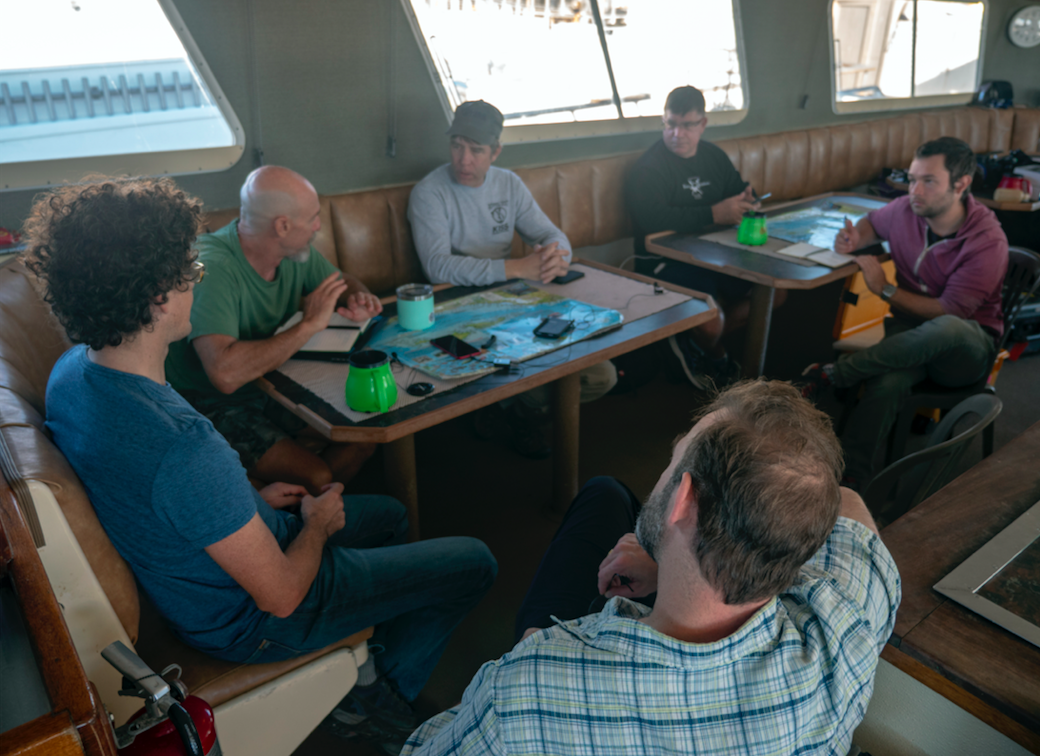
This gave us an extra day to prep all of the gear (time which I really needed) and discuss agenda items. It had only been a little over a month since I last dove in a cave but I was still struggling to gather and assemble all my gear together. Luckily, the team that surrounded me knew exactly where to jump in and help. During the afternoon we were given a brief tutorial on how to use Sébastien’s Mnémo tool, a remarkable artifact on which you feed the line you are laying as you progress through a cave, which can survey many aspects of your journey. This would be the key instrument for gathering data inside the cave.
At 4am the Conception departed the Santa Barbara harbour and we headed south towards the islands. I woke up soon after because I started rolling around from side to side on my bunk. After a couple of hours I realized that I was not going to go back to sleep anytime soon, so I decided to get up and head to the deck. The surge was heavy and the ship was swaying up and down. I began wondering how prone I was to seasickness, but it was already too late to wonder. I immediately felt my stomach moving up into my throat and my sight getting completely out of balance. So stumbling out to the deck I made my way to fresh air, where I believed I would be safe and did my best to suppress those feelings.
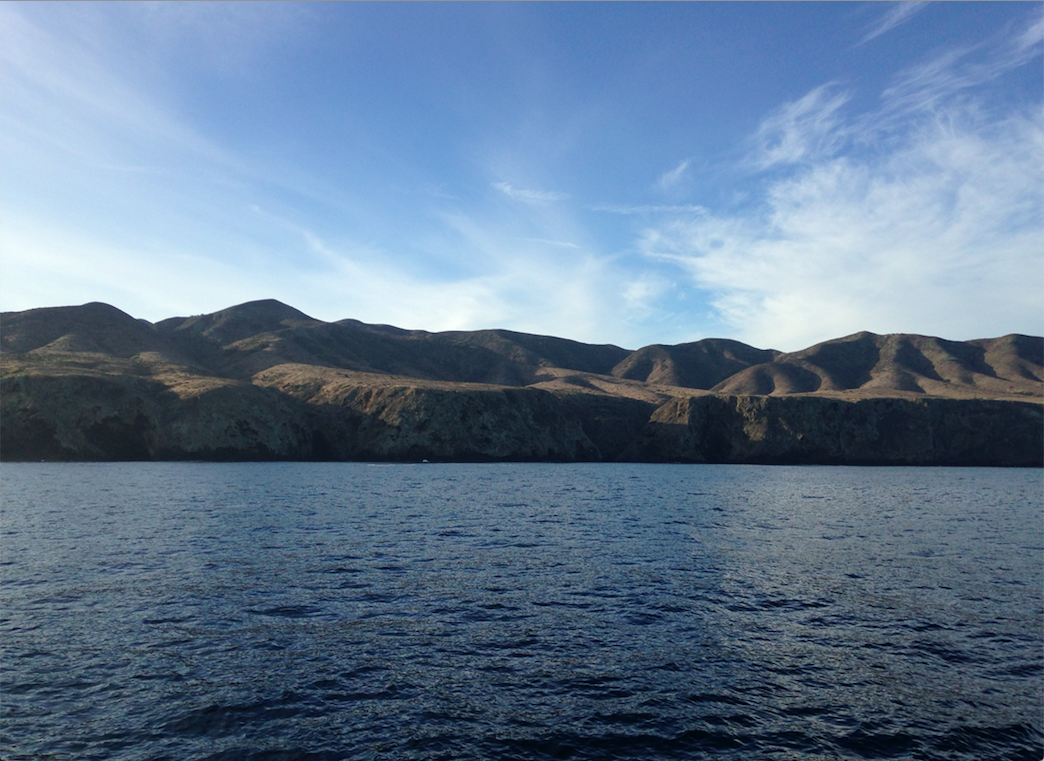
We finally arrived at Santa Cruz island at a site called Seal Cove, right where our first target cave would be. My excitement drowned any thoughts of seasickness that I had and before I knew it the team was already geared up and ready to start working. Jeff Bozanic went in first to scout out the site and determine whether conditions were adequate for diving. After confirming that we would do initial rounds to gather as much data as possible despite the weather, the first team went in, and soon after, the next. I was keeping track of people’s dive stats, noting air pressure, depth and bottom time. Suddenly I was called by Jill Heinerth and Kenny Broad, asking if I would help light up the cave entrance for Jill’s photogrammetry work. With zero hesitation I nodded and slipped into my drysuit. It was like finally the months I had spent training in different environments and acquiring several skills would be put to practice. This was the chance to combine those days spent diving in caves, adding on the extra complexity of a drysuit and applying the knowledge gained in photogrammetry. I was ready.
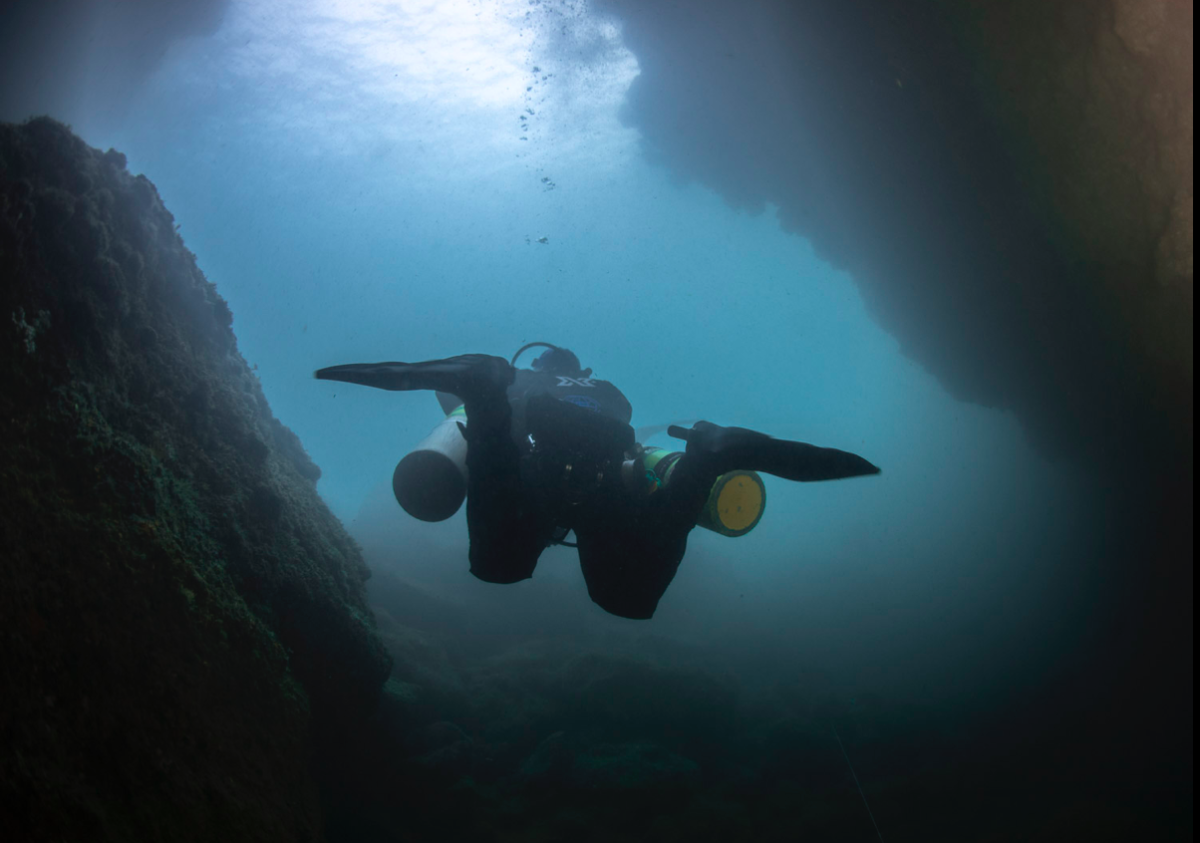
Or was I? As soon as I hit the water my memory went blank and I had forgotten how to set up my gear for caves. In fact, I was already in the water and realized that I needed fins, which I hadn’t even unpacked from my bags. But I took a few breaths and my muscle memory started to switch into action. Kenny Broad fetched my fins, then I put on my helmet, set my lights and down I went, following Jill Heinerth into the entrance of my first sea cave. If forgetting my fins was not embarrassing enough for a first dive, my right tank kept slipping from my bungee cords and falling right to the floor. It took me a couple of tries to finally get it to stay put. But I managed well and despite the swell pushing and sucking us in and out of the cave we were able to attempt the first photogrammetric digitalization of the cave entrance. Results were good and we decided that this was going to be our focus for the next day – to finish off collecting the images for the photogrammetry of the cave entrance. Which meant that I got to assist Jill Heinerth lighting up the cave and watch her in action.
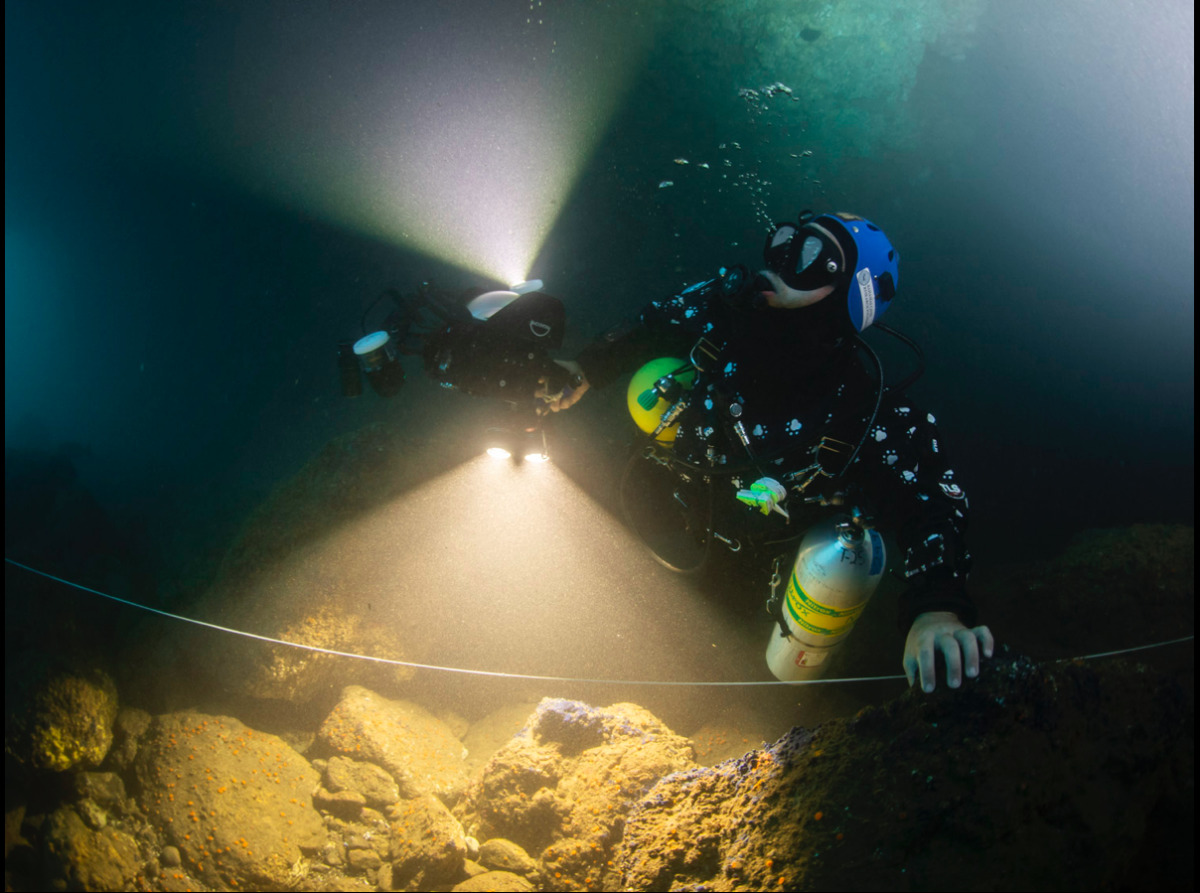
It was really cool to see the team be malleable and adapt to changing conditions. For instance, it turned out that diving a rebreather was not the best way to photograph the cave entrance with such an unstable ocean. Jill ended up improvising a side-mount harness with one of the extra wings and backplates available! It turns out that on these expeditions, one has to be prepared for anything, as oftentimes access to the perfect tools or equipment for such specialized dives is not guaranteed. After a series of subsequent successful dives we wrapped up for the day and gathered for a nightly meeting.
We determined that, as the ocean kept getting rougher, the safest decision would be to abandon the site and return back to the harbour. We set sail that night and got back safely, but did bounce and sway as we crossed the channel to the mainland.
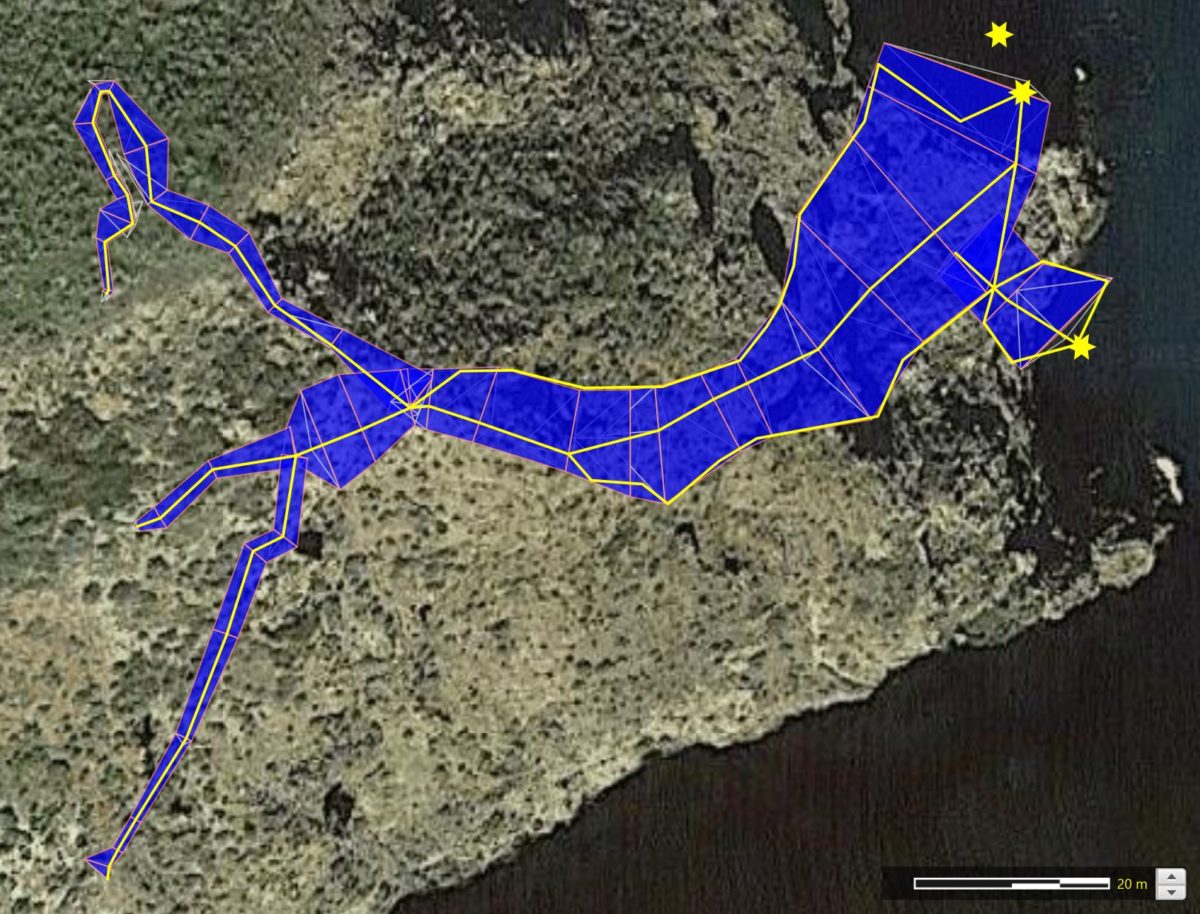
Although it was unfortunate that our trip got cut short a little early, I had had the opportunity to jump in the water several times alongside these cave diving gurus (as Brian Kakuk likes to call them). And I got to see some of our results from just a couple of days’ work. As people started to leave, Jill and I stayed behind catching up on other work. Glad we stayed an extra couple of days as I got a special treat, being invited by Bob Evans – an astonishing inventor and designer of the Force Fin, and his wife Susanne, out for dinner. They gave us a tour of Lad Handelman’s place, one of the earliest pioneers in the diving industry and shared stories that will be hard to forget!
We woke up the next day and drove south to Los Angeles, podcasting through the pitch black morning and getting ready for our next destinations.
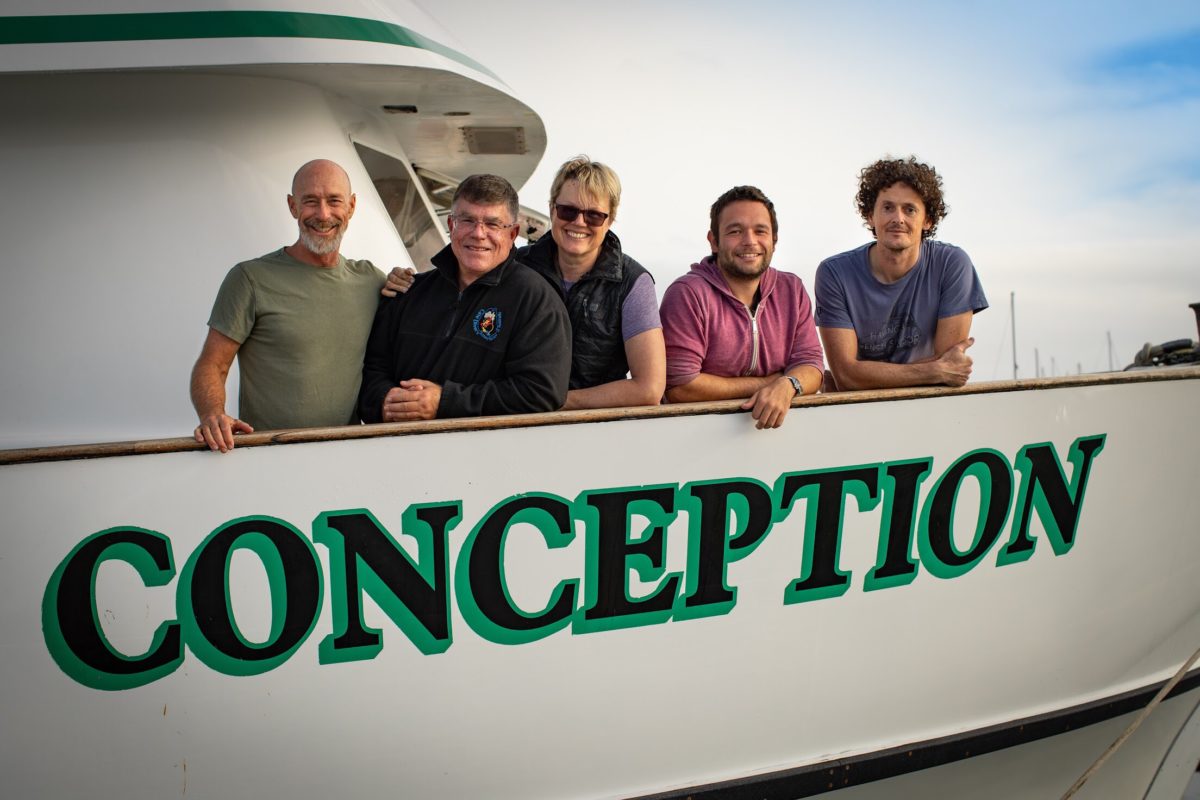
Huge thanks to my sponsors
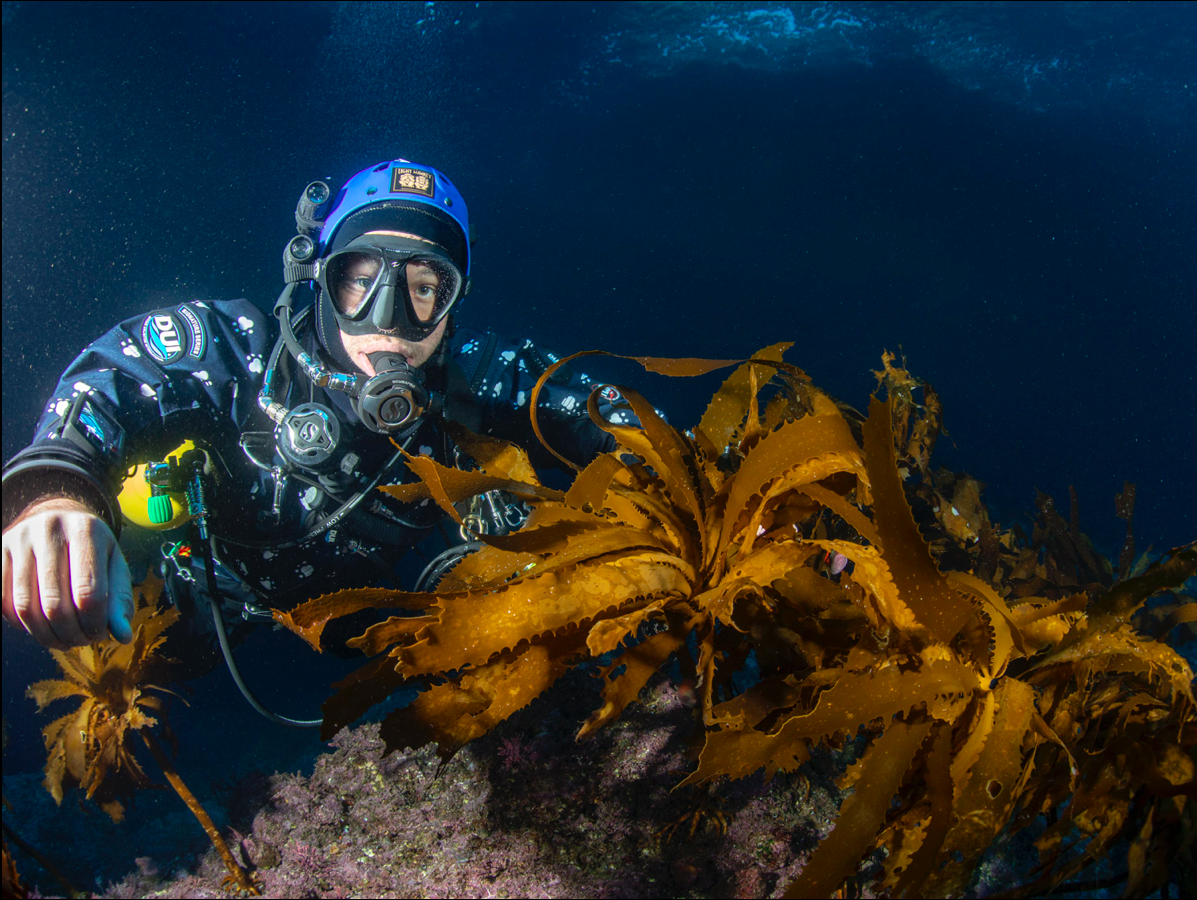
Mapeando la cueva de Seal Cove
Cuando recibí una invitación para unirme a un grupo de los mejores exploradores y buzos de cuevas para ayudar a ‘mapear’ parte de la costa sumergida de las islas del canal de Santa Bárbara (Channel Islands), fue la evidencia perfecta de que el entrenamiento que estaba recibiendo como becario realmente empezaba a dar frutos. Pero cuando me di cuenta que la expedición a la que me habían invitado era parte de una serie de exploraciones lideradas por el ‘Ocean Exploration Trust’, bajo dirección del Dr. Bob Ballard – el científico detrás del descubrimiento del Titanic, sabía que este viaje sería un paso adelante en mi carrera. Aunque era incierto si iba a poder trabajar como buzo ya que el perfil de buceo era muy demandante y fuera de mi nivel de entrenamiento, existía la posibilidad de que pudiera ayudar en buceos más someros. En cualquier caso realmente no me importaba. En ese momento me sentía privilegiado de poder contribuir en la superficie tomando datos con tan solo poder presenciar la ejecución de una expedición de tan alto nivel de trabajo.
Llegamos en la tarde para subirnos al Conception, barco operado por la compañía Truth Aquatics. Esta iba a ser la primera vez que me embarco en un buque de buceo por días consecutivos. Me subí a la cubierta con todo mi equipaje y reconocí la cara de Brian Kakuk, quien había sido mi instructor de cuevas hace unos meses. Me acerqué para saludar y me presentaros al resto del equipo, conformado por Kenny Broad, Jill Heinerth, Jeff Bozanic, Mike Young, Sébastien Kister y Allan Adams. Todos buzos quienes han hecho del deporte lo que es de una manera u otra. Y por encima de todos, eran muy amigables. Después de conocer al capitán del barco y la tripulación, se decidió que prolongaríamos la salida un día más debido a las condiciones climáticas ya que el mar estaba muy movido para salir.

Gracias a la demora tuve un poco más de tiempo para organizar mi equipo de buceo, lo cual fue muy ventajoso. A pesar de que solo había pasado un mes desde la última vez que bucee en cuevas ya me sentía un poco oxidado. Por suerte, el equipo a bordo sabía exactamente mi situación y supo exactamente dónde intervenir y ayudarme. Durante la tarde Sébastien nos dio un pequeño tutorial de cómo operar el Mnémo, una herramienta creada por él que utilizaríamos para tomar datos de la cueva conforme avanzáramos sobre la línea. Este instrumento es crucial para poder tener un mapa acertado de la cueva.
A las cuatro de la mañana el Conception salió del puerto de Santa Bárbara y nos dirigimos al sur hacia las islas del canal. Me desperté inmediatamente porque empecé a rodar de un lado de mi litera a otro. Después de unas horas me di cuenta que no iba a poder dormir más, entonces me levanté y me fui a la cubierta. La marea era tan pesada que el barco se movía para arriba y para abajo, lo cual me puso a pensar qué tan susceptible era yo al mareo. Pero era demasiado tarde. Ya sentía el estómago apretarme por encima de la garganta y la vista completamente desbalanceada. Y así, tropezándome entre las maletas, logré salir a la cubierta donde soplaba el viento. Aquí hice lo posible por pensar que lo fresco me quitaría el mareo y traté de suprimir los demás pensamientos.

Finalmente llegamos a la isla Santa Cruz, a un sitio llamado Seal Cove donde se encontraba nuestra primera cueva. Mi emoción inundó cualquier pensamiento que tenía de mareo y cuando me di cuenta el equipo ya estaba poniendo manos a la obra. Jeff Bozanic fue el primero en entrar al agua y hacer una inspección del sitio de trabajo para determinar si las condiciones eran aceptables para trabajar. Confirmamos que el equipo iba a entrar y tratar de recopilar la mayor cantidad de datos posibles antes de que aumentara más la marea. Y así se echó al agua el primer grupo, y luego el segundo. Mientras yo me estaba encargando de tomar los datos de presión de aire de los cilindros en superficie. De repente, Kenny Broad y Jill Heinerth me llamaron pidiendo que ayudara a Jill a sostener las luces para el trabajo de fotogrametría que Jill empezaría en la entrada de la cueva. Sin pensarlo dos veces me puse mi traje seco de volada. Sentía que finalmente los meses que pasé entrenando en diferentes condiciones y adquiriendo diferentes habilidades se iban a poner a prueba. Esta era la oportunidad de combinar las sesiones buceando en cuevas, sumándole la complejidad del traje seco, con el conocimiento que había adquirido sobre el proceso de fotogrametría. Estaba listo.

¿O realmente lo estaba? Tan pronto toqué el agua y mi memoria se nubló. Se me había olvidado completamente cómo armar mi equipo para bucear en cuevas. Es más, ¡ya estaba en el agua y me di cuenta que no tenía puestas las aletas! Ni siquiera las había sacado de mi maleta. Pero tomé unos respiros y poco a poco mi memoria cobró vida. Kenny Broad fue por mis aletas, me puse el casco, prendí mis luces y me fui para abajo junto con Jill hacia la entrada de la primera cueva. Por si no fuera suficientemente vergonzoso haber entrado al agua sin aletas en la primera inmersión de la semana, mi tanque derecho seguía zafándose de mi arnés y cayéndose al suelo. Me tomó unos cuántos arreglos poderlo estabilizar y amarrar a mi cuerpo. A pesar de las complicaciones, y la marea que seguía incrementando succionando y escupiéndonos de la entrada de la cueva, Jill y yo logramos hacer las primeras tomas para digitalizar una sección de la cueva. Los resultados fueron buenos y decidimos que en esto nos íbamos a enfocar los siguientes días para poder terminar de tomar las fotos necesarias para la fotogrametría de la entrada de la cueva. Lo que quería decir que yo iba a poder asistir a Jill Heinerth sosteniendo las luces y verla en acción.

Fue increíble ver el equipo tan maleable y adaptarse a las condiciones cambiantes. Por ejemplo, al final resultó que usar un equipo de circuito cerrado, rebreather, no era la mejor opción para fotografiar la entrada de la cueva con la marea tan fuerte. Jill terminó improvisando un sidemount usando una de las alas y placas que sobraban. Parece ser que en este tipo de expediciones no puedes contar con que habrá todo el equipo que necesitas para hacer buceos tan especializados, por lo que tienes que estar preparado para lo que sea. Después de una serie de inmersiones exitosas con nuestra nueva configuración de equipo, terminamos la serie de documentación de la entrada de la cueva y nos preparamos para una reunión con los demás.
Determinamos que conforme el mar se ponía cada vez más fuerte, la decisión más segura era abortar la misión y regresar al puerto. Salimos esa misma noche y regresamos a salvo, pero si rebotamos de un lado al otro mientras cruzábamos el canal hacia tierra firme.

Aunque fue inoportuno tener que cancelar el viaje a medias, tuve la tremenda oportunidad de meterme al agua con un grupo de maestros del buceo en cuevas, y de ver los resultados de tan solo unos pocos días de trabajo. Conforme desembarcaba la gente y se movían a sus siguientes destinos, Jill y yo nos quedamos atrás poniéndonos al corriente con otras tareas. Estoy muy feliz de que nos quedamos unos días más ya que tuve la oportunidad de conocer a Bob Evans y su esposa, quienes inventaron un tipo de aleta llamada Force Fin. Nos dieron un recorrido por la casa de Lad Handelman, uno de los pioneros de la industria del buceo. Nos contaron historias que serán difíciles de olvidar.
Despertamos al día siguiente y manejamos hacia Los Ángeles, entre la oscura y densa madrugada.

Muchísimas gracias a mis patrocinadores
